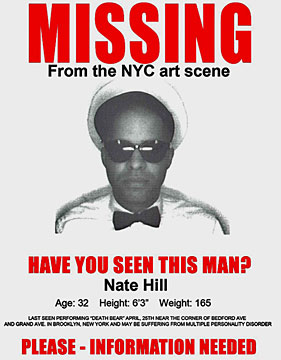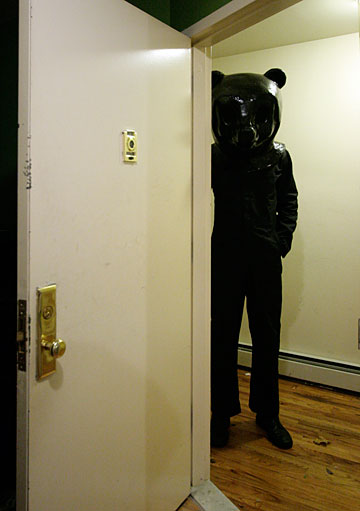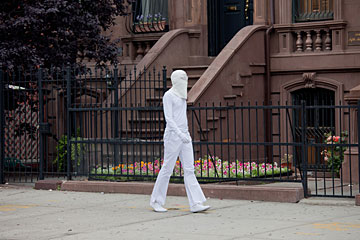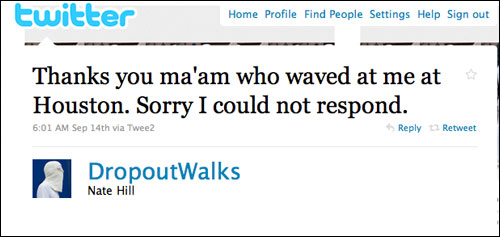
A "missing" poster that the artists places up on the routes of his detachment walks. Unfortunately, some people he knew took it a little too literally.
Earlier this summer, performance artist Nate Hill made an announcement:
Following on the heels of Death Bear (RIP), Mr. Dropout is an unexpected continuation on detachment. While Death Bear aided people in their detachment from objects, Mr. Dropout embodies the detachment itself.
I’d known Nate through his work, which has received extensive press. I’ve also seen him quite frequently around Chelsea. He easily stands out: tall and elegant with a quiet gait and pleasant, even shy demeanor, he’s usually dressed as a milk man, complete with a box of fake milk bottles. After he made the announcement, I found time to watch his performance come to life on Broadway near Macy’s and Herald Square and shot the following video.
[vimeo:https://vimeo.com/13675917]
Though his performance is mysterious, even opaque, I was struck by his use of Twitter not just to announce his Detachment Walks but to create a secondary layer of performance, an opportunity to quite literally speak from behind the veil. I spoke with him via email about his latest project.
An Xiao: Thanks, Nate, for agreeing to chat with me. Let’s start with a basic question: where did you get the idea for Mr. Dropout?
Nate Hill: I was moving on from my character Death Bear, who was the man dressed as a bear that performed house calls to strangers where he took objects causing you pain back to his cave where they disappeared forever. I did not know what my next character was going to be, but I knew I was ready to bring something new. Even though I had nothing to give in that moment, I decided to give you this “nothing” that I had and make a piece that was about coming up with an idea for a new identity. I want to present myself as art even when I don’t have real art to present.

One of Hill's most famous performances, Death Bear, involved him traveling to individuals' homes to relieve them of cherished belongings. Even in this analog performance, he utilized new media: Death Bear was summoned via text message only. Image by Kevin Walsh.
AX: And yet, in sharing this “nothing,” you’ve created quite a character. Why the specific form in took?
NH: It’s a negative space costume. As I’ve stated too many times on my Twitter because I like to drill it into your head, I am not here. Like a white canvas before something is painted on it, Mr. Dropout is concerned with what can be painted on him.
AX: That makes a great segue to my next question: how did you decide to incorporate Twitter? It seems to run counter to the negative space idea, like you’re painting on the canvas already.
NH: I wanted to project new identities for myself and this character somewhere. Mr. Dropout is blank and the Twitter is where he is (in an imaginary fashion) filled in. I have stockpiled over a hundred new identity ideas on my Twitter since the piece began over two months ago. For example, “Mr. Dropout is a performance pointing to a performance (twitter), but what about a perf. within a perf. within a perf., like a babushka doll?” (source)
Also, I utilized Twitter daily to notify people at least a day beforehand where my Detachment Walks would occur in New York City, as well as my location at the intermission of the walk if you missed the beginning or were hoping to catch me along the way. I saw Twitter as a tool of communication to facilitate a performance piece.

The artist walking around Harlem as Mr. Dropout. Image by Tod Seelie.
AX: I noticed you had so many different uses and identities. How has your use of Twitter evolved over time? How have folks responded?
NH: I am most proud of the people who used the interactivity of Twitter to suggest new identities for me.
For example, “RT @39forks: @DropoutWalks Walk & observe all.. people. Whenever U see anyone pointing, walk in the direction…Repeat for duration.”
My use of Twitter hasn’t changed much because I set up my first account this July when I started this piece and have only mostly discussed this piece with my account. What has changed is how I feel about the over four hundred people that I’m following. When I read their tweets, sometimes I feel a self-righteousness and self-importance that I’m using Twitter to facilitate a specific art project, and most of them are not, as if this dedication makes me better.
Then a moment later, I’ll feel irritated that I don’t have the freedom to tweet, “Just had the best cheeseburger of my life!” So I go back and forth on loving and hating the limitations that I’ve tried to keep with my account. Hence, the over six hundred tweets I have accumulated have mostly all been about the same thing—Mr. Dropout and who he is and who he will become. To most people, I think this has probably been boring because it is so focused on one thing. To me, it could not be more interesting.
There lies a problem.

Even from up close, the performance is mysterious and fleeting, even frightening at times. On Twitter, Hill ultimately shares his humanity and desire to connect with others.
AX: I feel like you do cover a few personal items here and there (by the way, if you like cheeseburgers, I have to bring you to In-N-Out some time), but you’re right, you have a strong focus on your specific project. How do you see yourself resolving this “problem”? Do you think it’s a major problem?
NH: Your expectations for a project’s popularity will determine whether it’s a major problem or not, but I feel it’s problematic because I usually do art for a broad audience. The blogs usually pick it up, and my work usually becomes good water cooler conversation. I miss that.
I knew this project was not going to be that when I started, but I still miss it. Perhaps it’s not just the esoteric nature of Mr. Dropout that has limited my followers to just over two hundred, but also the newness of trying to convince people that I’m making art on Twitter? That’s not a common thing.
AX: Given your desire to reach a broad audience, do you see yourself using Twitter for future projects?
NH: The next piece which I am secretly planning will not depend on Twitter the way Mr. Dropout does. The reason is that I want to go back to having a presence in real life.
I miss going to people’s homes and sitting on their couch as Death Bear. I miss talking with my mouth. I miss sitting on the subway benches and having girls get on my lap and bouncing as the Free Bouncy Rides dolphin. Honestly, I just miss the physical connection with people, and I think I really needed Twitter for this piece because without it, there would have been no connection with people, and I do performance art because I thrive on interaction with people.
If you look at my work, there’s always some interaction with people in every piece. Twitter provided that for Mr. Dropout, who, of course, does not interact with people on the street.

Type in "Nate Hill" in Google, and the search engine suggests his most popular projects. Already, "Twitter" is fourth on the list.
AX: That’s interesting—yes, your work is very interactive, and Mr. Dropout is not. Twitter allows for that interaction. What has been the greatest limitation of Twitter for you?
NH: It’s been difficult figuring out how to fit an “art project-based” Twitter into the interactive world of the regular casual Twitter [users]. Sometimes, I look at it and think, “This doesn’t fit.”
It’s been a challenge responding to some of the feedback I’ve gotten from my followers, because some of it had a tone that was too light and jokey for me because I was trying to present this as a serious artwork. Sometimes, I felt like an overly serious dad working in his office, while his child pulled at his leg wanting to play.
Also, it’s been a challenge to suggest new identities every day or at least frequently to keep the piece moving because even I feel bored sometimes with the project’s focus especially when people are talking about current events. I get left out.
AX: Do you think you’ll use Twitter in the future for general use? I.e., can we expect an @natehill account any time soon?
NH: I don’t know if I need a personal twitter because I already say enough regrettable things in real life! 🙂 That’s why this project’s boundaries were good for me, but maybe I’ll start a new account or just change the @DropoutWalks name to @natehill when the project’s done. Can you do that?
AX: Yep! That’s actually pretty easy. And don’t worry – everyone says something silly on Twitter every so often. That’s what I like about it; it reveals a common humanity.
So it’s time to wrap up. What do you think about social media art in general? A passing fad, or does it have some staying power?
NH: I think time will tell.
Artist and designer An Xiao looks at the impact of new technologies in our lives as digital meets analog. She photographs, installs, performs and tweets and has shown her work in publications and art spaces internationally, including the Brooklyn Museum, the Pacific Asia Museum, Yale/Haskins Laboratories, The New York Times and Art in America. Recently listed in The Guardian’s “Who’s who” of the Twitter art world, she writes extensively on social media art as a contributing columnist for Art21 and writer for Brooklyn-based Hyperallergic.




Pingback: Tema de discusión para esta semana « León De la Rosa
Pingback: Relational Aesthetics and Nate Hill | 1 Weird Old Tip
Pingback: Umění pod vlivem jiných – 25fps